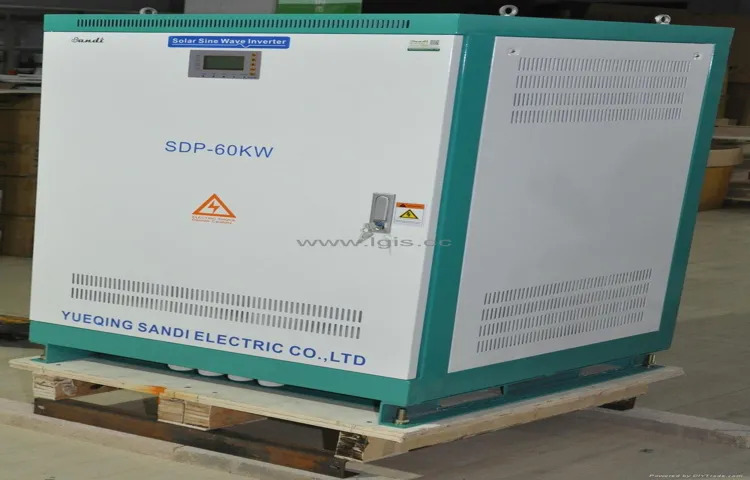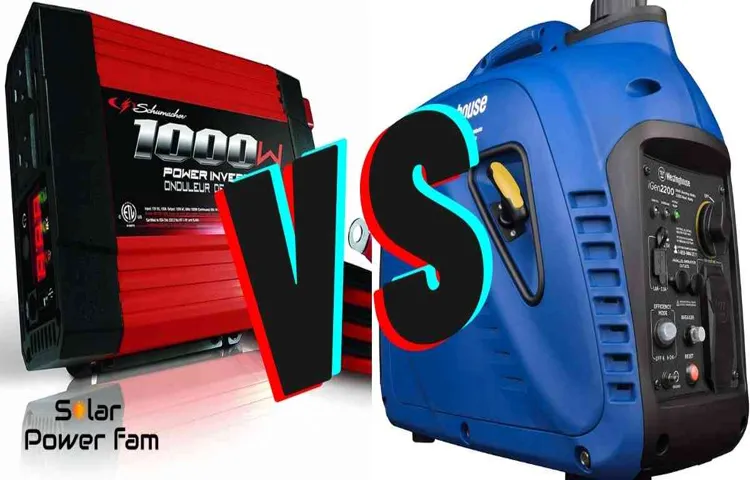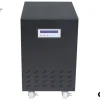If you’re planning on using a power inverter, you may be wondering how to determine the right size for your needs. After all, choosing the wrong size power inverter can lead to inefficiency, potential damage to your electrical devices, or even a complete lack of power when you need it most. But don’t worry, finding the right size power inverter doesn’t have to be complicated.
In this blog post, we’ll break down the steps you need to take to determine the perfect size power inverter for your specific needs. So grab a cup of coffee, sit back, and let’s dive in!
Table of Contents
Understanding Power Inverters
When it comes to choosing the right power inverter for your needs, it’s important to consider a few key factors. One of the most important factors is the size or capacity of the power inverter. In order to determine how big of a power inverter you need, you first need to consider the power requirements of the devices you plan to use with the inverter.
This includes considering both the starting power and the continuous power requirements. Some devices, such as power tools or appliances with motors, require a higher amount of power when they first start up, known as the starting power or surge power. This surge power requirement can be many times higher than the continuous power requirement.
To accommodate for this surge power, it’s recommended to choose a power inverter that has a surge power capacity that is higher than the surge power requirements of all the devices you plan to use with it. Additionally, you’ll also need to consider the continuous power requirements of your devices. This is the amount of power needed to keep the device running once it has started.
To determine the continuous power requirement, you can check the device’s specifications or look for information such as the wattage or amperage rating. It’s important to choose a power inverter that has a continuous power capacity that is higher than the total continuous power requirements of all the devices you plan to use with it. This ensures that the inverter can supply enough power to all the devices without overloading or overheating.
In conclusion, choosing the right size of power inverter requires considering both the surge power and continuous power requirements of the devices you plan to use with it. By selecting an inverter with a suitable surge power capacity and continuous power capacity, you can ensure that your devices run smoothly and efficiently.
What is a power inverter?
power inverter, understanding power inverters

Why do you need a power inverter?
power inverter, understand power inverters, why you need a power inverter
Calculating Your Power Needs
So, you’re looking to figure out how big of a power inverter you need. Well, first things first, let’s talk about what a power inverter is. Basically, it’s a device that converts DC power from your car’s battery into AC power that you can use to charge or power your devices.
Now, the size of the power inverter you need depends on what you plan on using it for. The most important factor to consider is the wattage of the devices you want to use. You see, every device has a wattage rating, which tells you how much power it consumes.
To determine the size of the power inverter you need, simply add up the wattage ratings of all the devices you plan on using at the same time. But here’s the thing, you can’t just add up the wattage ratings and call it a day. You also need to consider something called “surge power” or “peak power”.
This refers to the extra power that devices require when they first start up, and it’s usually higher than their normal operating power. So, you need to account for this surge power when calculating your power needs. To be on the safe side, it’s always better to choose a power inverter with a slightly higher wattage rating than what you actually need.
This way, you’ll have some extra power for unexpected surges or if you decide to add more devices in the future. So, when it comes to determining how big of a power inverter you need, just remember to consider the wattage ratings and surge power of your devices. And don’t forget to choose one with a slightly higher rating to be on the safe side.
Happy inverting!
Step 1: Determine the wattage of your devices
Calculating Your Power Needs When it comes to setting up your first solar power system, the first step is to determine the wattage of your devices. This is crucial because it will help you figure out how many solar panels and what size battery you’ll need to meet your energy requirements. To calculate the wattage, all you need to do is look at the labels on your devices or check their specifications online.
These labels usually provide information on the power consumption in watts. For example, if you have a laptop that consumes 60 watts and a refrigerator that consumes 250 watts, you would add these together to get your total wattage. It’s important to account for all the devices you plan to run from your solar power system, including TVs, lights, fans, and other appliances.
So take the time to make a list and gather all the necessary information in order to accurately calculate your power needs.
Step 2: Calculate the total wattage needed
When it comes to calculating your power needs for a new project or renovation, it’s important to consider the total wattage needed. This will ensure that you have enough power to run all of your devices and appliances without overloading your electrical system. To determine the total wattage, you’ll need to add up the power requirements for each of your devices.
This can be done by checking the labels or manuals that came with your appliances, or by using an online power consumption calculator. Once you have the power requirements for each device, simply add them all together to get the total wattage needed. This will give you a clear idea of the size of the electrical system you’ll need and help you avoid any potential power issues down the line.
So, whether you’re planning a new home theater setup or upgrading your kitchen appliances, take the time to calculate your power needs and ensure a smooth, efficient electrical system.
Step 3: Consider the surge power
Calculating Your Power Needs: Step 3 – Consider the surge power When it comes to determining your power needs, it’s important to consider the surge power. Surge power refers to the temporary increase in power that certain appliances or equipment require when they start up. This surge can be significantly higher than the normal power consumption of the device.
Why is surge power important to consider? Well, let’s think about it this way. Imagine you’re planning a camping trip and you want to bring along a portable generator to power your appliances and devices. You calculate that the total power consumption of all your devices is 2000 watts.
So, you might think that a generator with a rated power output of 2000 watts would be sufficient. However, if you fail to consider the surge power, you could run into trouble. When you start up certain devices, such as refrigerators, air conditioners, or power tools, they require a surge of power to get them going.
This surge can be two to three times higher than the normal power consumption of the device. If your generator is not equipped to handle this surge, it may overload and shut down, leaving you without power. To avoid this inconvenience, it’s important to account for surge power when calculating your power needs.
How do you do this? First, you need to identify the devices that have a surge power requirement. This information can usually be found in the device’s specifications or user manual. Next, you need to determine the surge power rating of each device.
This is usually indicated as a multiplier of the device’s rated power consumption. For example, a refrigerator may have a surge power rating of 5, meaning its surge power requirement is
Step 4: Account for efficiency
When it comes to calculating your power needs for an efficient system, there are a few key factors to consider. First, you’ll want to take into account the power draw of each individual component in your system. This includes everything from the CPU and GPU to the hard drives and fans.
By adding up the power draw of each component, you can get a rough estimate of the total power needs of your system. Next, you’ll want to account for any future upgrades or additions you may make to your system. For example, if you plan on adding more RAM or upgrading your graphics card in the near future, you’ll want to factor in the increased power draw these upgrades will require.
This will ensure that you choose a power supply that is capable of supplying enough power for your system both now and in the future. It’s also important to consider the efficiency of your power supply. Power supplies are rated for efficiency, typically ranging from 80% to 90%.
This means that for every 100 watts of power drawn from the wall, only 80 to 90 watts are delivered to your system. By choosing a power supply with a higher efficiency rating, you can minimize wasted energy and reduce your electricity costs over time. Lastly, it’s worth considering any peripherals or external devices you may have connected to your system.
These can include things like monitors, speakers, and USB devices. Each of these devices will have its own power draw, and it’s important to factor this into your overall power needs. In conclusion, calculating your power needs for an efficient system involves considering the power draw of each individual component, accounting for future upgrades, taking into account the efficiency of your power supply, and factoring in any peripherals or external devices.
By carefully considering these factors, you can ensure that your system has enough power to operate efficiently and reliably.
Step 5: Find the right inverter size
When it comes to choosing the right inverter size for your solar power system, it’s important to calculate your power needs accurately. This involves taking into account the total energy consumption of the appliances and devices you plan to run on solar power. By determining the wattage of each device and estimating their usage time, you can calculate the total power requirement.
For example, if you have a refrigerator with a power rating of 200 watts and it runs for 8 hours a day, you would need an inverter capable of handling 1600 watt-hours (200 watts x 8 hours) of power. By doing this for all the appliances and devices in your system, you can get a clear understanding of the total power demand and choose an inverter size that can meet these needs effectively. Remember, it’s always better to choose an inverter with a slightly higher capacity than your calculated power requirement to account for any future additions or expansions to your solar power system.
Choosing the Right Inverter Size
Have you ever wondered how big of a power inverter you need? Choosing the right size inverter is crucial to ensure that you have enough power to run your desired appliances or devices. One way to determine the size of the power inverter you need is by analyzing the power requirements of the devices you plan to use. Start by listing all the appliances or devices you intend to power with the inverter.
Then, check the user manual or specifications of each device to find the power consumption in watts. Add up the wattage of all the devices to get the total power requirement. It’s important to choose an inverter that can handle the total power requirement and leave some headroom for any unexpected power surges or surges in demand.
So, next time you’re thinking of purchasing a power inverter, make sure you consider the power requirements of your devices to choose the right size for your needs.
Standard sizes and their applications
choosing the right inverter size, standard sizes, applications, Choosing the right size of inverter is crucial for ensuring the proper functioning of your electrical system. Inverters come in a range of standard sizes, each designed for specific applications. It’s important to understand your power requirements and the electrical devices you plan to use with the inverter before making a selection.
The first step in choosing the right inverter size is assessing your power needs. Consider the total wattage of the devices you want to power and their starting current requirements. This will give you an idea of the power capacity you should look for in an inverter.
Next, you’ll need to consider the standard sizes available in the market. Inverters usually come in sizes ranging from 300 watts to several kilowatts. The size you choose will depend on the scale of your electrical system and the devices you plan to run.
For smaller systems or just powering a few small appliances, a 300 to 500-watt inverter may suffice. However, if you have a larger system or want to power higher wattage devices such as air conditioners or power tools, you may need to look at inverters in the range of 1000 to 3000 watts or more. It’s also important to consider the applications of different inverter sizes.
Smaller inverters are often used for mobile applications such as RVs, boats, or camping, where the power requirements are limited. On the other hand, larger inverters are commonly used in residential or commercial settings, where higher power capacities are needed to run multiple devices simultaneously. In conclusion, choosing the right inverter size involves assessing your power needs, considering the available standard sizes, and understanding the specific applications of each size.
By taking these factors into account, you can ensure that your electrical system runs smoothly and efficiently.
Factors to consider in choosing the right size
When choosing the right inverter size for your needs, there are a few important factors to consider. First and foremost, you need to determine the power requirements of the devices you plan on running with the inverter. This will help you decide whether you need a small inverter for basic electronic devices or a larger inverter for more power-hungry appliances like refrigerators or power tools.
Another factor to consider is the capacity of your battery bank. If you have a limited battery capacity, you may want to choose a smaller inverter to prevent draining your batteries too quickly. On the other hand, if you have a large battery bank, you have the flexibility to choose a larger inverter to accommodate future power needs.
It’s also worth considering the surge capacity of the inverter. Some devices, such as refrigerators or air conditioners, require a higher power surge when they start up. Make sure to choose an inverter with enough surge capacity to handle these power spikes without shutting down.
By taking these factors into account, you can ensure that you choose the right inverter size for your specific needs.
Other considerations
Choosing the right inverter size for your solar panel system is an important decision that can impact the overall performance and efficiency of your system. There are several factors to consider when determining the appropriate inverter size for your installation. One key consideration is the size of your solar panel array.
The inverter you choose should be able to handle the maximum power output of your panels. If the inverter is undersized, it may not be able to effectively convert the DC power from the panels into usable AC power for your home or business. On the other hand, if the inverter is oversized, it may not operate at its peak efficiency, leading to wasted energy and decreased performance.
Another factor to consider is the type of inverter you plan to use. There are several different types of inverters available, including string inverters, microinverters, and power optimizers. Each type has its own unique advantages and limitations, and the size of your inverter may depend on the specific type you choose.
It’s also important to consider the future expansion of your solar panel system. If you plan to add more panels in the future, you’ll need to ensure that your inverter has enough capacity to handle the additional power output. It may be more cost-effective to install a slightly larger inverter initially, rather than having to upgrade to a larger inverter down the line.
Ultimately, choosing the right inverter size requires careful consideration of your specific needs and goals. Consulting with a solar professional or installer can help you determine the best inverter size for your system, ensuring optimal performance and efficiency for years to come.
Conclusion
So, to summarize: choosing the right size power inverter is essential if you want to harness the power of the cosmos, wield the energy of the sun, and have the ability to turn your toaster into a time machine. With a small inverter, you may only be able to power a few devices, like your phone and a small electric toothbrush. But with a larger, more formidable inverter, you can bring light to the darkest corners of your life, charge your electric vehicle, and maybe even power the dreams of your entire neighborhood.
Remember, when it comes to power inverters, size does matter. So go big, my friend, and let the universe bow to your boundless electric power!”
FAQs
What is a power inverter and what does it do?
A power inverter is a device that converts direct current (DC) power from a battery into alternating current (AC) power for use in appliances and electronic devices.
How does a power inverter work?
Power inverters use electronic circuits to switch the DC power from a battery in a rapid and controlled fashion, allowing it to imitate the alternating current (AC) power that is used by most appliances and devices.
What are the different types of power inverters?
There are three main types of power inverters: modified sine wave, pure sine wave, and square wave. Modified sine wave inverters are the most common and affordable, but may not be suitable for all devices. Pure sine wave inverters produce a cleaner and more stable power output, while square wave inverters are less common and used for specific applications.
How do I determine the size/power of the inverter I need?
To determine the size of the power inverter you need, you’ll need to add up the power requirements (in watts) of all the devices you plan to use simultaneously. It’s recommended to choose an inverter that can handle a slightly higher wattage to account for power surges or fluctuations.
How can I calculate my power requirements for an inverter?
To calculate your power requirements, you’ll need to know the wattage of each device you plan to use. Add up the wattage of all devices you plan to use simultaneously, and choose an inverter with a higher wattage capacity to ensure it can handle the load.
Can I use a power inverter with my car battery?
Yes, you can use a power inverter with your car battery. However, it’s important to ensure that your car’s electrical system can handle the additional load. Consult your car’s manual or a professional to determine the maximum power load your car can support.
Can I run sensitive electronic devices with a power inverter?
Yes, you can run sensitive electronic devices with a power inverter. However, it’s recommended to use a pure sine wave inverter for such devices, as they provide a cleaner and more stable power output that is less likely to cause damage to sensitive electronics.



